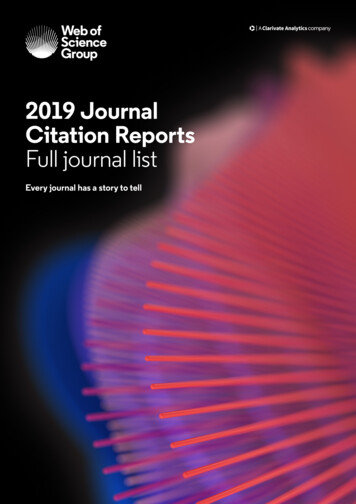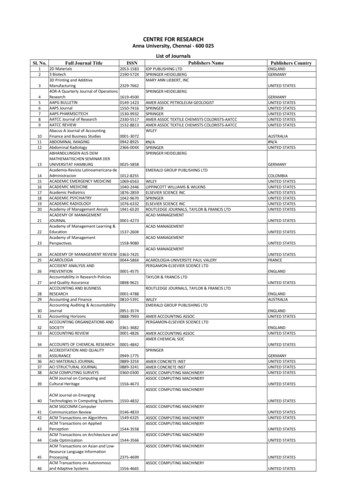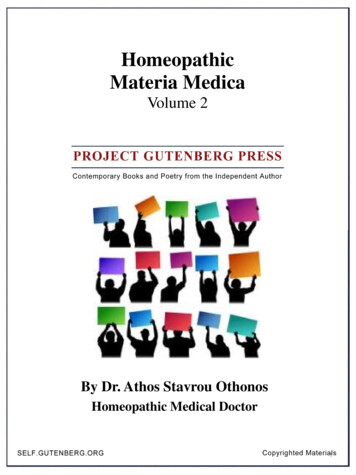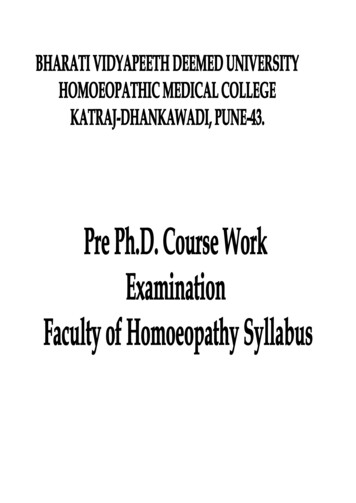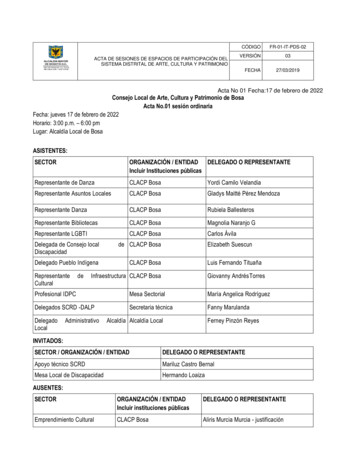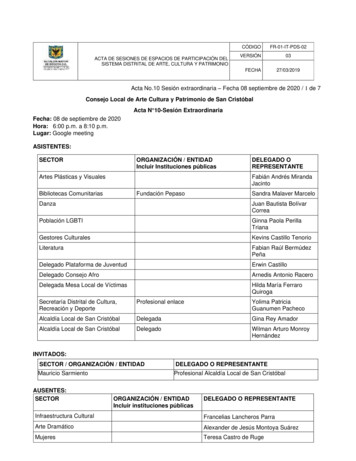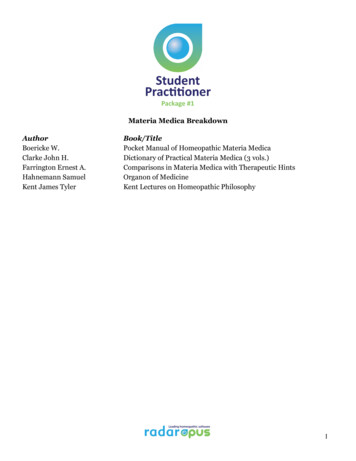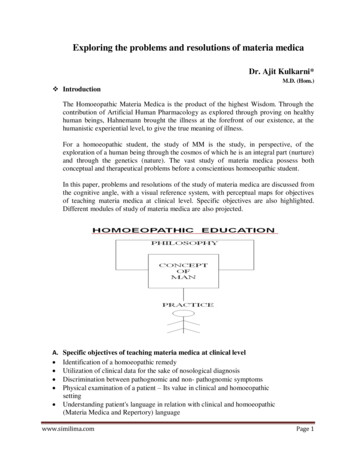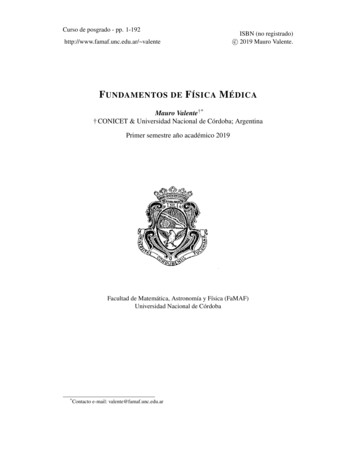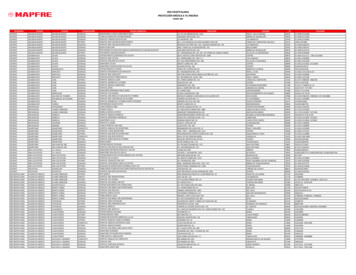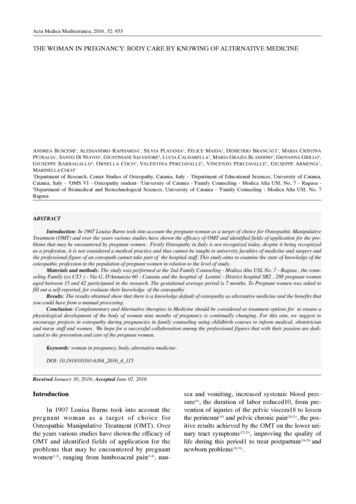
Transcription
Acta Medica Mediterranea, 2016, 32: 953THE WOMAN IN PREGNANCY: BODY CARE BY KNOWING OF ALTERNATIVE MEDICINEANDREA BUSCEMI1, ALESSANDRO RAPISARDA1, SILVIA PLATANIA2, FELICE MAIDA3, DEMETRIO BRANCAT13, MARIA CRISTINAPETRALIA2, SANTO DI NUOVO2, GIUSTINIANI SALVATORE4, LUCIA CALDARELLA5, MARIA GRAZIA BLANDINO5, GIOVANNA GRILLO5,GIUSEPPE BARBAGALLO4, ORNELLA COCO4, VALENTINA PERCIAVALLE2, VINCENZO PERCIAVALLE6, GIUSEPPE ARMENIA7,MARINELLA COCO61Department of Research, Center Studies of Osteopathy, Catania, Italy - 2Department of Educational Sciences, University of Catania,Catania, Italy - 3OMS VI - Osteopathy student- 4University of Catania - 5Family Counseling - Modica Alta USL No. 7 - Ragusa 6Department of Biomedical and Biotechnological Sciences, University of Catania - 7Family Counseling - Modica Alta USL No. 7RagusaABSTRACTIntroduction: In 1907 Louisa Burns took into account the pregnant woman as a target of choice for Osteopathic ManipulativeTreatment (OMT) and over the years various studies have shown the efficacy of OMT and identified fields of application for the problems that may be encountered by pregnant women. Firstly Osteopathy in Italy is not recognized today, despite it being recognizedas a profession, it is not considered a medical practice and thus cannot be taught in university faculties of medicine and surgery andthe professional figure of an osteopath cannot take part of the hospital staff. This study aims to examine the state of knowledge of theosteopathic profession in the population of pregnant women in relation to the level of study.Materials and methods: The study was performed at the 2nd Family Counseling - Modica Alta USL No. 7 - Ragusa , the counseling Family (ex CT3 ) - Via G. D'Annunzio 60 - Catania and the hospital of Lentini - District hospital SR2 . 288 pregnant womenaged between 15 and 42 participated in the research. The gestational average period is 7 months. To Pregnant women was asked tofill out a self-reported, for evaluate their knowledge of the osteopathyResults: The results obtained show that there is a knowledge default of osteopathy as alternative medicine and the benefits thatyou could have from a manual processing.Conclusion: Complementary and Alternative therapies in Medicine should be considered as treatment options for to ensure aphysiological development of the body of woman nine months of pregnancy is continually changing. For this aim, we suggest toencourage projects in osteopathy during pregnancies in family counseling using childbirth courses to inform medical, obstetricianand nurse staff and women. We hope for a successful collaboration among the professional figures that with their passion are dedicated to the prevention and care of the pregnant woman.Keywords: woman in pregnancy, body, alternative medicine.DOI: 10.19193/0393-6384 2016 4 115Received January 30, 2016; Accepted June 02, 2016IntroductionIn 1907 Louisa Burns took into account thepregnant woman as a target of choice forOsteopathic Manipulative Treatment (OMT). Overthe years various studies have shown the efficacy ofOMT and identified fields of application for theproblems that may be encountered by pregnantwomen(1,2), ranging from lumbosacral pain(3-8), nau-sea and vomiting, increased systemic blood pressure(9), the duration of labor reduced10, from prevention of injuries of the pelvic viscera18 to lessenthe perineum(19) and pelvic chronic pain(20,21), the positive results achieved by the OMT on the lower urinary tract symptoms(22,23), improving the quality oflife during this period1 to treat postpartum(24-29) andnewborn problems(30,31).
954It’s important to not forget a key advantage ofOsteopathy, that is the total absence of use of narcotics on a pregnant woman.Even though there is a wide selection of international articles on the effectiveness of OMT during pregnancy, there is a lack in the treatment ofthese subjects in the Osteopathic Italian clinics.This phenomenon can be explained both by the relatively young age of Osteopathy in Italy (thenational Register of Osteopaths of Italy, Registrodegli Osteopati d’Italia, R.O.I. was founded in1989) and also the lack of an official status of thisprofession, which was obtained by Law n. 4 of 14January of 2013 (published on Gazzetta Ufficialedella Repubblica Italiana, Serie Generale n.22, 2601-2013). Another fact that affects the “unawareness” of the entire population is given by the factthat the formation of Osteopaths in provided exclusively by private schools(32-40). Firstly Osteopathy inItaly is not fully recognized today, despite it beingrecognized as a profession, it is not considered amedical practice and thus cannot be taught inUniversity’s Medical Schools and the professionalfigure of the Osteopath is not part of the medicalstaff in the hospital(41-51).The present study aims to examine the state ofknowledge of the osteopathic profession in generaland of specific osteopathic techniques interventionin pregnancy, in particular, within a large sample ofpregnant women.Materials and methodsSubjectsA total of 288 pregnant women aged between15 and 42 participated in the research. The gestational average period was 28 weeks ( 3.3 SD).This research work is an observational study,aimed to evaluate and to verify the level of knowledge of practice osteopathic in pregnant women.The pregnant woman had to fill out a selfreported questionnaire for evaluating her knowledge of the osteopathy. The questionnaire had onlyone answer to be selected (figure 1).The pregnant women were fully informed ofthe purpose of the study and signed an informedconsent prepared according to the ethical standardslaid down in the Declaration of Helsinki (revision2013).The study was performed at the 2nd FamilyCounseling - Modica Alta USL No. 7 - Ragusa , thecounseling Family (ex CT3) - Via G. D’AnnunzioAndrea Buscemi, Alessandro Rapisarda et Al60 - Catania and the hospital of Lentini - Districthospital SR2. The childbirth courses, with the participation of pregnant women, was performed 2014to April 2015.Figure 1: Questionnaire submitted to the subjects forevaluating her knowledge of the osteopathy.Statistical analysisData was collected and averaged, and thencompared by using one-way repeated measuresanalysis of variance (ANOVA; Friedman test), followed by post-hoc Dunn’s Multiple ComparisonTest. The relationship between variables was analyzed with linear regression. Significance was set atp 0.05 and all data are reported as mean standard deviation (SD). All analyses were performedby means of using GraphPad Prism version 6.03 forWindows (GraphPad Software, San Diego, CA,USA).ResultsTable 1 shows some characteristics of the 288subjects; as can be seen, 25 subjects had an agefrom 15 to 18 years (9%), 90 subjects aged from 19to 27 years (31%), 165 subjects aged from 28 to 40years (57%) and the remaining 8 subjects aged over40 years (3%).
The women in pregnancy: body care by knowing of alternative medicineTable 1 shows also that 22 subjects wasdivorced (7%), 144 subjects were partner in anunmarried couple (49%), 65 subjects were single(23% ) and only 61 subjects was married (21%).955then 69% of the sample has no adequate knowledge.Moreover, 62% of pregnant women believedthat manual therapy is right for treatment of bonediseases or thought it was useful for pain reduction(2b).In fact, 54% think that Osteopathy reducesosteoporosis in pregnancy or say it is useful to ameliorate postural changes induced by pregnancy (figure 2c).Table 1: Characteristics of participants relative to: age(years), marital status, educational qualification.Moreover, Table 1 illustrates that the subjectshad an education degree distributed as follows: 49subjects had a Doctoral degree (17%), 45 subjectshad a Bachelor ’s degree (16%), 26 subjectsacquired a title after a professional Course (9%),116 subjects had a high school diploma (40%) and,finally, 52 subjects had a middle school diploma(18%).Figure 3: Answers about to the questions: In what stageof a pregnancy can you consult an osteopath? Have youever addressed an Osteopath? Were you satisfied withthe treatment?Oddly, the majority of pregnant women doesnot know what is the role of Osteopathy but theythink that after three months of gestation anosteopath may be consulted (Figures 3a). The mostof pregnant women never consulted an Osteopath(Figures 3b, 3c) and no one ever recommended anosteopath.DiscussionFigure 2: Answers about to the questions: Do you knowwhat Osteopathy is? Why does one need Osteopathy? Inpregnancy what is the aim of osteopathy?Figures 2 and 3 summarizes the results: it ispossible to observe that there was a basic knowledge of Osteopathy as alternative medicine andabout the benefits that it is possible to have from amanual processing.In fact, 40% of pregnant women think thatOsteopathy is a medical approach that deals withosteoporosis while 22% think that Osteopathy is abone disease and 7% did not answer (Figures 2a),The age of Osteopathy in Italy is of only 26years and this is surely the main reason of unawareness, or a confused knowledge, of the profession odOsteopath in both medical and community areas.However, in the last few years, these aspects havechanged in a positive way(52-57).The great effort made by the creation of ROIin the institutional and educational fields hasbrought this job to be known as a professionaloccupational figure.For the majority of pregnant women, it isclear that it is a profession not well known, oftenosteopathy is thought to deal with bone disease orwith a medical branch devoted to the therapy ofosteoporosis, and the competence of the osteopathare not known even though there is a wide collec-
956Andrea Buscemi, Alessandro Rapisarda et Altion of international literature which shows how itis used in different illnesses(58-62).This could be explained because in Italy theeducation in Osteopathy is given in private structures and not in Universities, and in this way itremains outside the educational, formational andcommunicational systems.Complementary and alternative medicine(CAM) therapies may be considered as an optionfor to ensure a physiological development of thebody of women during the nine months of pregnancy(63).As example, it is known that the pregnancyrelated back pain is often associated with sleep disturbance and it may affect the activities of daily living and, therefore, the quality of life(64-67).Licciardone et al observed that the OMTdecreases of back pain and related symptoms during the third trimester of pregnancy(68).For this reason, it seems to be important toencourage initiatives intended to pregnant womenwho provide for the intervention of osteopaths, fora successful collaboration among the professionalfigures dedicated to the care of the 3)4)5)6)7)Lavelle JM. Osteopathic manipulative treatment inpregnant women. The Journal of the AmericanOsteopathic Association. 2012: 112(6), pp. 343-6.Borggren CL. Pregnancy and chiropractic: a narrativereview of the literature. Journal of ChiropracticMedicine. 2007: 6, pp. 70-74.Peterson CD, Haas M, Thomas W. A pilot randomizedcontrolled trial comparing the efficacy of exercise,spinal manipulation, and neuro emotional techniquefor the treatment of pregnancy-related low back pain.Chiropractic & Manual Therapies. 2012: 20(18), pp.16.Mac Evilly M, Buggy D. Back pain and pregnancy: areview. Pain. 1996: 64(3), pp. 405-14.Pennick VE, Young G. Interventions for preventing andtreating pelvic and back pain in pregnancy. CochraneDatabase Syst Rev.2007: 18;(2), CD001139.Licciardone JC, Buchanan S, Hensel KL, King HH,Fulda KG, Stoll ST. Osteopathic ManipulativeTreatment of Back Pain and Related Symptoms duringPregnancy: A Randomized Controlled Trial. TheAmerican Journal of Obstetrics & Gynecology. 2010:202(1), pp. 43.e1-43.e8. doi:10.1016/j.ajog.2009.07.057.Laslett M. Evidence-Based Diagnosis and Treatment ofthe Painful Sacroiliac Joint. The journal of manual &manipulative therapy. 2008:16 (3), pp.142-152.16)17)18)19)20)21)Kristiansson PK, Svärdsudd von Schoultz B. Back painduring pregnancy: a prospective study. Spine. 1996: 21(6), pp. 702-709.Kwong KF, Krasna MJ. Thoracoscopic sympathectomy.In: Shields TW, LoCicero J, Reed CE, Feins RH,eds. General thoracic surgery. 7a ed.LippincottWilliams & Wilkins: Philadelphia, PA, 2009:657.Whiting LM. Can the length of labour be shortened byosteopathic treatment. The Journal of AmericanOsteopathic Association. 1911:11, pp. 917-921.Alagona G, Coco M, Rapisarda G, Costanzo E, Maci T,Restivo D, Maugeri A, Perciavalle V. Changes of bloodlactate levels after repetitive transcranial magneticstimulation. Neuroscience Letters. 2009; 450, 111-113.doi: 10.1016/j.neulet.2008.11.064. Epub 2008 Dec 6.Coco M, Di Corrado D, Calogero R A, Perciavalle Va,Maci T, Perciavalle V. Attentional processes and bloodlactate levels. Brain Research. 2009; 1302: 205-211.doi: 10.1016/j.brainres.2009.09.032. Q 2Garifoli A, Laureanti F, Coco M, Perciavalle V, Maci T,Perciavalle V. Neuronal NOS expression in rat'scuneate nuclei following passive forelimb movementsand median nerve stimulation. Archives ib.v148i4.1022.Coco M, Alagona G, Perciavalle V, Cicirata V,Perciavalle V. Spinal cord excitability is not influencedby elevated blood lactate levels. Somatosensory andMotor Research. 2011; 28(1-2): 19-24.Donia M, Mangano K, Fagone P, De Pasquale R,Dinotta F, Coco M, Padron J, Al-Abed Y, LombardoGA, Maksimovic-Ivanic D, Mijatovic S, Zocca MB,Perciavalle V, Stosic-Grujicic S, Nicoletti F. Uniqueantineoplastic profile of Saquinavir-NO, a novel NOderivative of the protease inhibitor Saquinavir, on thein vitro and in vivo tumor formation of A375 humanmelanoma cells. Oncol Rep. 2012; 28(2): 682-8. doi:10.3892/or.2012.1840. Epub 2012 May 29.Coco M, Perciavalle V, Maci T, Nicoletti F, Di CorradoD, Perciavalle V. The second-to-fourth digit ratio correlates with the rate of academic performance in medical school students. Molecular Medicine Report. 2011;4(3): 471-6. doi: 10.3892/mmr.2011.456. Epub 2011Mar 15Fagone P, Donia M, Mangano K, Quattrocchi C,Mammana S, Coco M, Libra M, McCubrey JA,Nicoletti F. Comparative Study of Rapamycin andTemsirolimus Demonstrates Superimposable AntiTumour Potency on Prostate Cancer Cells. Basic &clinical pharmacology & toxicology. 2013 Jan;112(1):63-9. doi: 10.1111/j.1742-7843.2012.00923.x. Epub2012 Jul 26.Heit M, Mudd K, Culligan P. Prevention of childbirthinjuries to the pelvic floor. Current Women’s HealthReports. 2001: 1(1), pp. 72-80.Howard FM. Chronic pelvic pain. Obstetrics &Gynecology. 2003:101(3), pp. 594-611.Tu FF, As-Sanie S, Steege JF. Musculoskeletal causesof chronic pelvic pain: a systematic review of existingtherapies: part II. Obstetrical & gynecological survey.2005: 60(7), pp. 474-83.Tettambel MA. An osteopathic approach to treatingwomen with chronic pelvic pain. The Journal of
The women in pregnancy: body care by knowing of alternative American Osteopathic Association. 2005: 105(9 Suppl4), 20-2.Hay-Smith J, Mørkved S, Fairbrother KA, HerbisonGP. Pelvic floor muscle training for prevention andtreatment of urinary and fecal incontinence in antenatal and postnatal women. Cochrane Database Syst 007471.Franke H, Hoesele K. Osteopathic manipulative treatment (OMT) for lower urinary tract symptoms (LUTS)in women. Journal Of Bodywork And MovementTherapies. 2012: 17(1), pp. 11-18. doi:10.1016/j.jbmt.2012.05.001.Terry RR, Westcott J, O’Shea L, Kelly F. PostpartumOutcomes in Supine Delivery by Physicians vs Nonsupine Delivery by Midwives. The Journal of theAmerican Osteopathic Association. 2006: 106, pp. 199202.Dumoulin C, Hay-Smith J. Pelvic floor muscle trainingversus no treatment, or inactive control treatments, forurinary incontinence in women. Cochrane DatabaseSyst Rev. 2010: 20(1):CD005654. DOI:10.1002/14651858.Spaeth DG. Observatory clues to aid in the diagnosingof diastasis symphysis pubis: an underreported complication of parturition. The Journal Of The AmericanOsteopathic Association. 1997: 3, pp. 152-155.Chang JL, Wu V. External fixation of pubic symphysisdiastasis from postpartum trauma. Orthopedics.2008:31(5), p. 493.Baytur YB, Serter S, Tarhan S, Uyar Y, Inceboz U,Pabuscu Y. Pelvic floor function and anatomy afterchildbirth. Journal of Reproductive Medicine. 2007:52(7), pp. 604-610.Jonasson A, Larsson B, Pschera H. Testing and training of the pelvic floor muscles after childbirth. ActaObstetricia et Gynecologica Scandinivica. 1989: 68(4),pp. 301-304.Sullivan C. Introducing the cranial approach inosteopathy and the treatment of infants and mothers.Complement Ther Nurs Midwifery. 1997: 3(3), pp. 726.Sergueef N, Nelson KE, Glonek T. Palpatory diagnosisof plagiocephaly. Complement Therapies in ClinicalPractise. 2006: 12(2), pp. 101-110. Doi:10.1016Perciavalle V, Di Corrado D, Petralia MC, Gurrisi L,Massimino S, Coco M. The second-to-fourth digit ratiocorrelates with aggressive behavior in professionalsoccer players. Molecular Medicine Reports. 2013;7(6): 1733-8. doi: 10.3892/mmr.2013.1426. Epub 2013Apr 10.Coco M, Alagona G, Perciavalle Va, Rapisarda G,Costanzo E, Perciavalle V. Brainstem excitability is notinfluenced by blood lactate levels. Somatosensory andMotor Research, 2013 Jun; 30(2): 90-5. doi:10.3109/08990220.2013.769949. Epub 2013 Mar 6.Perciavalle V, Apps R, Bracha V, Delgado-García JM,Gibson AR, Leggio M, Carrel AJ, Cerminara N, CocoM, Gruart A, Sánchez-Campusano R. ConsensusPaper: Current Views on the Role of CerebellarInterpositus Nucleus in Movement Control andEmotion. Cerebellum. 2013; 7, 10.1007/s12311-0130464-0Frinchi M, Macaluso F, Licciardi A, Perciavalle V,36)37)38)39)40)41)42)43)44)45)46)47)957Coco M, Belluardo N, Morici G, Mudò G. Recovery ofDamaged Skeletal Muscle in mdx Mice through Lowintensity Endurance Exercise. Int J Sports Med. 2014;35(1): 19-27. doi: 10.1055/s-0033-1343405. Epub 2013Jul 18.Fagone P, Patti F, Mangano K, Mammana S, Coco M,Touil-Boukoffa C, Chikovani T, Di Marco R, NicolettiF. Heme oxygenase-1 expression in peripheral bloodmononuclear cells correlates with disease activity inmultiple sclerosis. J Neuroimmunol. 2013; 15; 261(12): 82-6. doi: 10.1016/j.jneuroim.2013.04.013. Epub2013 May 25.Coco M, Alagona G, Perciavalle Va, Perciavalle Vi,Cavallari P, Caronni A. Changes in cortical excitabilityand blood lactate after a fatiguing hand-grip exercise.Somatosens Mot Res. 2014; 31(1): 35-39.(doi:10.3109/08990220.2013.834816).Mangano K, Fagone P, Bendtzen K, Meroni PL,Quattrocchi C, Mammana S, Rosa MD, MalaguarneraL, Coco M, Magro G, Marco RD, Nicoletti F.Hypomethylating Agent 5-Aza-2'-deoxycytidine (DAC)Ameliorates Multiple Sclerosis in Mouse Models. J 641.Perciavalle Va, Di Corrado D, Scuto C, Perciavalle Vi,Coco M. Anthropometrics related to the performanceof a sample of male swimmers. Perceptual & MotorSkills: Physical Development & Measurement. 2014;118, 3, 940-950. doi: 10.2466/19.50.PMS.118k27w8.Perciavalle Va, Di Corrado D, Scuto C, Perciavalle Vi,Coco M. Attention and blood lactate levels in equestrians performing show jumping. Perceptual & MotorSkills: Motor Skills & Ergonomics. 2014; 118, 3, 733745. doi:10.2466/29.30.PMS.118k22w1.Coco M, Sarra Fiore A, Perciavalle V, Maci T, PetraliaMC, Perciavalle Va. Stress exposure and postural control in young women. Molecular Medicine Reports.2015; 11(3): 2135-40. DOI: 10.3892/mmr.2014.2898.Coco M, Alagona G, De Maria G, Rapisarda G,Costanzo E, Perciavalle Vi, Perciavalle Va.Relationship of high blood lactate levels with latency ofvisual evoked potentials. Neurological Sciences. 2015;36(4): 541-6. doi: 10.1007/s10072-014-2015-y. Epub2014 Nov 26.Coco M, Gangemi A, D’Amico I, Inguì F, Ambra T,Perciavalle Va. Learning and kinematics of a particulartype of throwing. Acta Medica Mediterranea. 2015; 31:443.Perciavalle V, Alagona G, De Maria G, Rapisarda G,Costanzo E, Perciavalle V, Coco M. Somatosensoryevoked potentials and blood lactate levels. Neurol Sci.2015; 36(9): 1597-601. doi: 10.1007/s10072-015-22105. Epub 2015 Apr 17.Perciavalle Va., Maci T., Perciavalle Vi., Massimino S.,Coco M. Working memory and blood lactate levels.Neurological Sciences. 2015; 36(11): 2129-36. doi:10.1007/s10072-015-2329-4Perciavalle Va, Buscemi A, Borbone C, Catania A,Buscemi B, Petralia MC, Puglisi ML, Coco LSG, CocoM. Exhaustive exercise and short term memory. ActaMedica Mediterranea, 2015; 31: 1271. DOI10.19193/0393-6384 2016 1 03.Coco M, Perciavalle V, Cavallari P, Perciavalle V.Effects of an Exhaustive Exercise on Motor Skill
a Buscemi, Alessandro Rapisarda et AlLearning and on the Excitability of Primary MotorCortex and Supplementary Motor Area. MD.0000000000002978.Perciavalle V, Alagona G, Maci T, Petralia MC,Costanzo E, Perciavalle V, Coco M. Attentionalprocesses during submaximal exercises. 20.2013.796924. Epub 2013 Jun 5Perciavalle V, Bosco G, Poppele RE. Spatial organization of proprioception in the cat spinocerebellum.Purkinje cell responses to passive foot rotation. Eur JNeurosci. 1998; 10(6): 1975-85.Perciavalle V. Substantia nigra influences on the reticulospinal neurons: an electrophysiological andionophoretic study in cats and rats. Neuroscience.1987; 23(1): 243-51.Gray C, Perciavalle V, Poppele R. Sensory responses topassive hindlimb joint rotation in the cerebellar cortexof the cat. Brain Res. 1993; 622(1-2): 280-4.Perciavalle V, Santangelo F, Sapienza S, Serapide MF,Urbano A. Motor responses evoked by microstimulationof restiform body in the cat. Exp Brain Res. 1978;33(2): 241-55.Giuffrida R, Li Volsi G, Pantò MR, Perciavalle V,Sapienza S, Urbano A. Single muscle organization ofinterposito-rubral projections. Exp Brain Res. 1980;39(3): 261-7.Perciavalle V, Santangelo F, Sapienza S, Savoca F,Urbano A. Motor effects produced by microstimulationof brachium pontis in the cat. Brain Res. 1977; 13;126(3): 557-62.Pannuzzo G, Cardile V, Costantino-Ceccarini E,Alvares E, Mazzone D, Perciavalle V. A galactose-freediet enriched in soy isoflavones and antioxidantsresults in delayed onset of symptoms of Krabbe diseasein twitcher mice. Mol Genet Metab. 2010; 100(3): 23440. doi: 10.1016/j.ymgme.2010.03.021.Cardile V, Pavone A, Renis M, Maci T, Perciavalle V.Effects of Gabapentin and Topiramate in primary ratastrocyte cultures. Neuroreport. 2001; 13; 12(8): 17058.Berretta S, Bosco G, Giaquinta G, Smecca G,Perciavalle V. Cerebellar influences on accessory oculomotor nuclei of the rat: a neuroanatomical, immunohistochemical, and electrophysiological study. J CompNeurol. 1993; 1; 338(1): 50-66.Jessen MR, Shaenboen MJ. Simultaneous bilateralfacial palsy in pregnancy. The Journal of the AmericanOsteopathic Association. 1996: 96(1), pp. 55-57.Ashton-Miller JA, Delancey JO. On the biomechanicsof vaginal birth and common sequelae. Annual Reviewof Biomedical. 2009: 11, pp. 163-76. d D, Montgomery OC, Wehbe SA,Whitmore KE. Sacral nerve stimulation during pregnancy: case report and review of the literature. FemalePelvic Medicine & Reconstructive. 2012: 18(2), pp.127-129. doi: 10.1097/SPV.0b013e3182436ae9.Aukee P, Tihtonen K. Pregnancy, delivery and pelvicfloor disorders. Duodecim. 2010: 126 (20), pp. 23812386.62)63)64)65)66)67)68)69)70)Jiang HH, Pan HQ, Gustilo-Ashby MA, Gill B, GlaabJ, Zaszczurynski P, Damaser M. Dual simulated childbirth injuries result in slowed recovery of pudendalnerve and urethral function. Neurourol Urodyn. 2009:28(3), pp. 229-235. doi: 10.1002/nau.20632.Wang SM, DeZinno P, Fermo L, William K, CaldwellAndrews AA, Bravemen F, et al. Complementary andalternative medicine for low-back pain in pregnancy: across-sectional survey. J Altern Complement Med2005:11: 459-64.Fast A, Shapiro D, Ducommun EJ, Friedmann LW,Bouklas T, Floman Y. Low-back pain in pregnancy.Spine 1987:12: 368-71.To WW, Wong MW. Factors associated with back painsymptoms in pregnancy and the persistence of pain 2years after pregnancy. Acta Obstet Gynecol Scand2003: 82: 1086-91.Wang SM, Dezinno P, Maranets I, Berman MR,Caldwell-Andrews AA, Kain ZN. Low back pain during pregnancy: prevalence, risk factors, and outcomes.Obstet Gynecol 2004: 104: 65-70.Skaggs CD, Prather H, Gross G, George JW,Thompson PA, Nelson DM. Back and pelvic pain in anunderserved United States pregnant population: a preliminary descriptive survey. J Manipulative PhysiolTher 2007; 30: 130-4.Licciardone JC, Buchanan S, Hensel KL, King HH,Fulda KG, Stoll ST. Osteopathic manipulative treatment of back pain and related symptoms during pregnancy: a randomized controlled trial. Am J ObstetGynecol. 2010 Jan;202(1): 43.e1-8. doi:10.1016/j.ajog.2009.07.057. Epub 2009 Sep 2.Casabona A, Bosco G, Perciavalle V, Valle MS.Processing of limb kinematics in the interpositus nucleus. Cerebellum, 2010; 9: 103-10. doi: 10.1007/s12311009-0149-xCasabona A, Valle MS, Bosco G, Perciavalle V.Cerebellar encoding of limb position. Cerebellum,2004; 3: 172-177.Corresponding authorMARINELLA COCOmarinella.coco@unict.itCatania(Italy)
Windows (GraphPad Software, San Diego, CA, USA). Results Table 1 shows some characteristics of the 288 subjects; as can be seen, 25 subjects had an age from 15 to 18 years (9%), 90 subjects aged from 19 to 27 years (31%), 165 subjects aged from 28 to 40 years (57%) and the remaining 8 subjects aged over 40 years (3%).
